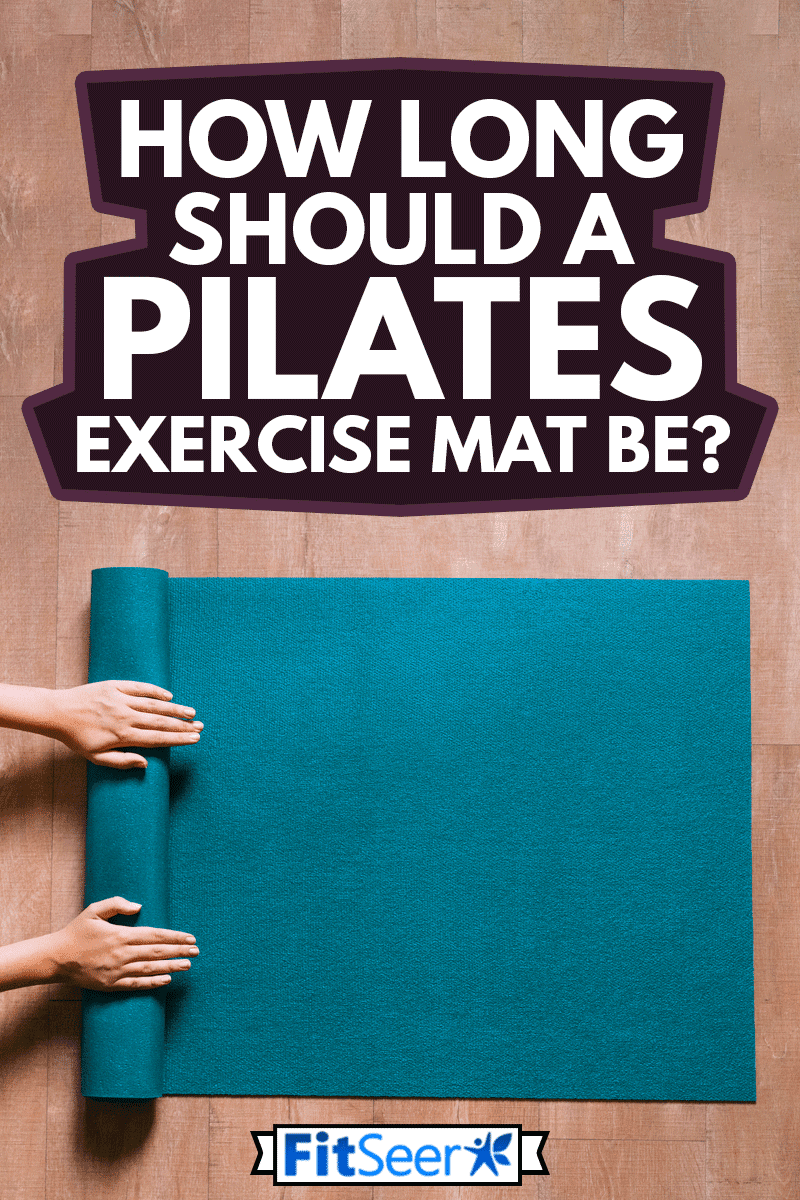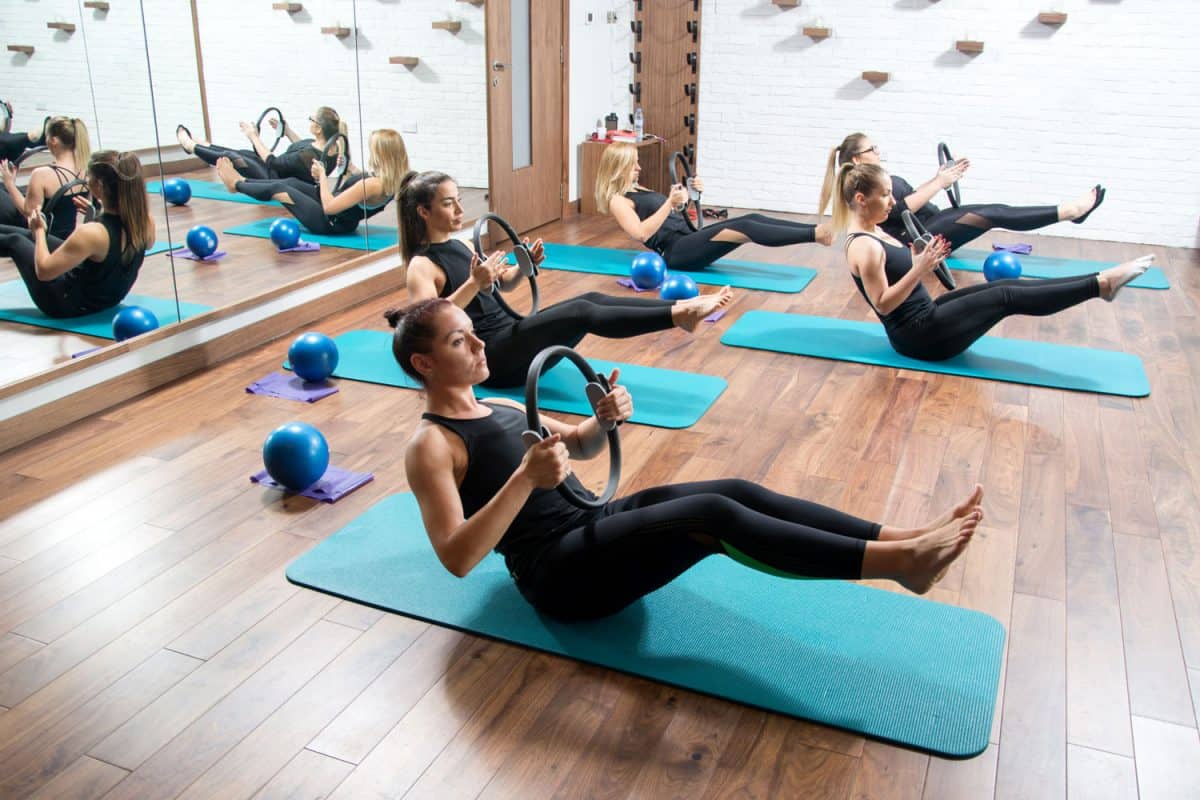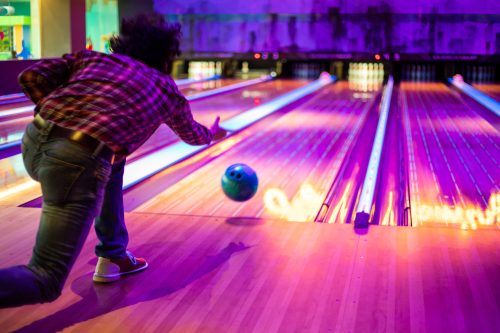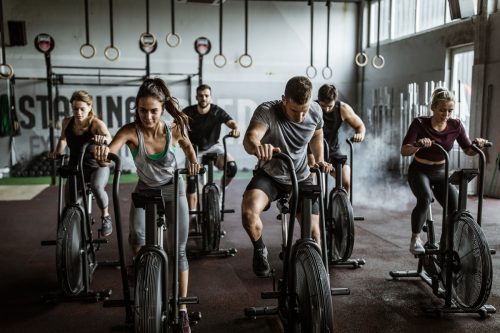Pilates is a low-impact, whole-body form of exercise that helps to strengthen your core and other muscles while improving your flexibility, posture, and balance. Participants perform most Pilates exercises either seated or lying on a mat, making the mat a crucial piece of equipment for anyone interested in Pilates. But you might be wondering: just how long should my Pilates exercise mat be? We've done the research and have all the answers you need to choose the right Pilates mat.
A standard Pilates exercise mat is 68 inches long and 24 inches wide. Larger Pilates mats are also commonly available, up to 72 inches long and up to 32 inches wide.
Keep reading for more information on choosing a Pilates mat, including how to decide which size Pilates mat you need. We'll also let you know the differences between Pilates and yoga mats, whether Pilates mats are thicker than yoga mats, and what else you'll need for Pilates.

How Long Should My Pilates Exercise Mat Be?
The standard size for a Pilates exercise mat is 68 inches long by 24 inches wide. This is generally the minimum size most people would want for Pilates, as a smaller mat might make it more challenging to perform some of the moves. Both longer and wider mats are also available, which some people may prefer.
Click here to check out this 68-inch long Pilates mat on Amazon.
How Do I Know What Size Pilates Mat to Get?

Taller people may want to opt for a longer Pilates mat, up to either 72 or even 74 inches long. Choosing a longer mat may make taller people feel more comfortable, though in general, it will not matter too much if your feet extend past the bottom of the mat while lying down to perform Pilates.
Depending on their body shape and level of flexibility, some people might also prefer a wider mat, which will provide more room to maneuver.
Because you often roll from back to front or side to side while transitioning between various Pilates exercises, a wider mat can help ensure your body has enough space to stay on the mat during your entire workout. You can find Pilates mats up to 32 inches wide.
You should also consider where you'll be performing Pilates when choosing the size of your mat. For at-home Pilates, you're limited only by the floor space where you plan to exercise and the space where you'll store the mat. This gives you the option to choose an exercise mat that's even longer and wider than the standard extended sizes.
If you plan to perform Pilates at a gym or Pilates studio, however, you'll want one that rolls up and is easy to carry, and you'll probably need to stick to a 72 by 32-inch mat at the largest.
Click here to check out this 72-inch long Pilates mat on Amazon.
What Else Should I Consider When Choosing a Pilates Mat?
Thickness
The average thickness for a Pilates mat is between 3/8- and a 1/2-inch thick. This is thicker than many other types of exercise mats, including yoga mats. You'll want the extra padding provided by a thicker mat because you'll perform so many Pilates moves lying down. Whether rolling on your back, lying on your side or kneeling, the extra cushioning will make performing Pilates much more comfortable and enjoyable.
A thicker mat that provides the right comfort and support will ensure you don't give up on your workout or skip specific exercises, and it will help you achieve better results from performing Pilates.
Texture
Pilates mats tend to have a smoother texture than yoga mats, which tend to be much more grippy. The smoothness can make it quicker and easier to transition from front to back or side to side while lying down for Pilates. A super-grippy surface might make it more difficult to easily slide between positions if your clothes or skin grip the mat.
However, some people might prefer a less slick surface. While less grippy than yoga mats, some Pilates mats still contain some extra ribbing or other texture on the surface.
You might want to choose a Pilates mat that has some texture or a nonslip surface on at least one side to help prevent sliding on a slick hardwood gym floor. If you plan to perform Pilates at home on a floor with a carpet or rug, the extra texture might not matter as much to you, though.
Material
Pilates mats are available in various materials, the most common being PVC foam and other synthetic materials like TPE or NBR. You can also find Pilates mats made from natural materials like rubber or cork.
What Is the Difference Between a Yoga Mat and a Pilates Mat?

A yoga mat's standard length and width are the same as the standard size for a Pilates mat: 68 inches long by 24 inches wide. Most people opt to use this standard size mat for yoga, while others choose to use a longer and wider mat for Pilates.
Yoga mats are thinner and grippier than Pilates mats, which are thicker and have a smoother texture. These differences might seem minimal, but choosing the proper mat for each exercise type makes a difference in ensuring the safest and most effective workout.
A textured grippy mat is crucial for yoga because you spend so much time performing standing and balancing poses. A smooth mat is likely to slip and slide while standing on it, making balancing more difficult and increasing the chances of injury.
Even when lying down, you often hold poses for several seconds or even minutes while performing certain types of yoga, such as yin yoga. Extra grip and texture can make it easier to maintain proper form for a longer amount of time.
Both the exercises and the transitions between them are generally faster in Pilates versus yoga. Because you don't need to hold poses in Pilates as you do in yoga, and because you may need to move quickly to perform them, an extra-grippy mat isn't necessary for Pilates and may even hinder you.
Are Pilates Mats Thicker than Yoga Mats?
Pilates mats are thicker than yoga mats. The average Pilates mat is 3/8- to 1/2-inch thick, while the average yoga mat is 1/8- to 1/4-inch thick.
Thicker mats provide more cushion, making them ideal for performing Pilates, where you spend most of the time lying on either your back or side or sitting down. Your spine, hips, and knees will appreciate the extra padding provided by a thicker mat.
While you also perform many sitting and lying down poses in yoga, you also spend a great deal of time standing. To perform standing or balancing yoga poses effectively, you need a stable base and for your feet to connect with the ground.
The thinner the mat, the easier it is to balance and achieve proper form with your standing yoga poses. A thinner mat lets you feel the ground and provides far more stability than a thicker mat would.
What Do You Need for Pilates?
To perform essential mat Pilates, all you need is a mat. But to get the most from your workout, you might want to pick up a few additional items.
Extra Equipment
Pilates is considered a strength and resistance training because you use your own bodyweight to create resistance and build muscle strength. However, you can increase the variety, intensity, and effectiveness of your Pilates workouts by incorporating additional equipment, like resistance bands, a Pilates ring, or ankle weights.
Click here to check out these resistance bands on Amazon.
Click here to check out this Pilates ring on Amazon.
Click here to check out these adjustable ankle weights on Amazon.
Grippy Socks
You don't need special shoes or clothes to perform Pilates, but a pair of grippy socks might make you more comfortable if your feet tend to get cold or you're worried about slipping on a hard floor. Also, in many Pilates studios, wearing grippy socks is required.
Click here to check out these grippy socks on Amazon.
Class/Instructor
You can find a Pilates studio or gym offering Pilates classes in most cities, but what if you'd rather perform Pilates at home? You can, of course!
Even beginners can follow along with a Pilates DVD or online class. Connecting a streaming device like a Roku to your TV makes it easy to browse for Pilates classes and perform them right in your living room.
Click here to check out this Roku streaming device on Amazon.
You can even browse YouTube for classes, like the one featured below, and choose your favorite in-home instructor:
In Closing
Now that you know what size mat you need for Pilates, what are you waiting for? Pilates is a fun, low-impact form of exercise anyone can perform right in their home.
It won't take long for you to see the results from your Pilates workout. Beginners and experienced fitness buffs will benefit from improved flexibility, core strength, balance, and posture. Pick up a mat, find a class to stream online, and get started with Pilates today!











![Read more about the article How Far Should I Hike In a Day? [Typical Numbers Revealed]](https://fitseer.com/wp-content/uploads/2020/11/Hikers-walking-on-a-hiking-trail-in-mountains-500x333.jpg)


